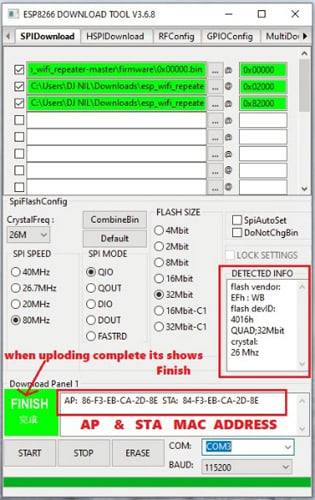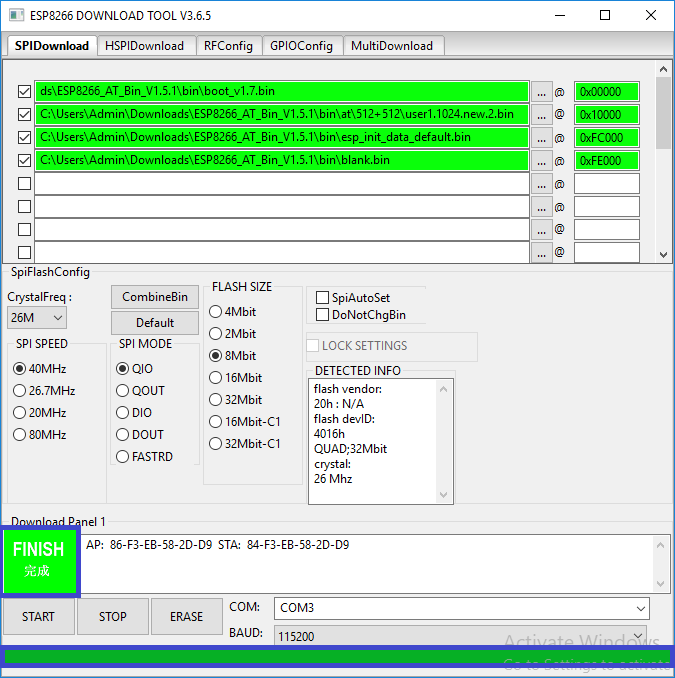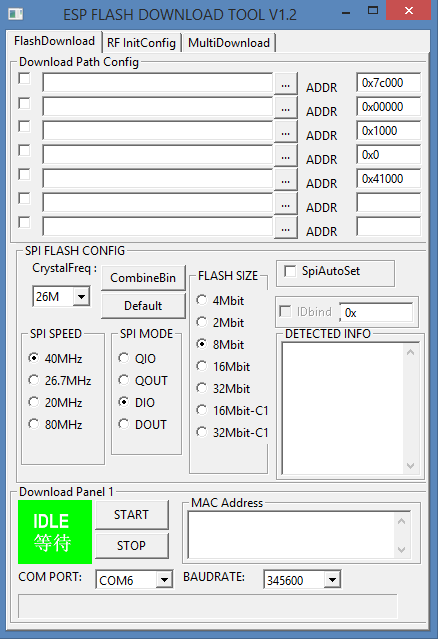When you buy the ESP module it will most likely have the factory AT or NodeMCU (LUA) firmware inside. To get the ESP Easy running, you need to replace the firmware with the ESP Easy firmware first.
Here's what has happened during the download tool process time: The download tool determined the size of the EEPROM on the module as 'QUAD;8Mbit,' which translates to 1Megabyte. The download tool determined the crystal speed to be 26MHz. The download tool read the MAC addresses for your ESP-01 module in both the AP (Access Point) mode and in. バイナリファイル.binをwindows上の書き込みソフトウェアesp flash download toolを使って書き込みます。 esp flash download toolのダウンロード; pcとesp-wroom-02はuartで接続します(usbシリアル変換が必要、ロジック電圧は3.3vです。一般的なusb-rs232c変換ケーブルは使えません)。. This is a short demo of how to use esptool to flash a firmware update on an ESP8266 Wifi module. I had a hard time figuring out how to do this using a Mac ru.
This can be done with a special flash upload tool that uses the ESP serial interface. You can download the latest stable ESP Easy build from our website. This downloadable zipfile contains the flash tool, a command batchfile to launch the actual flash process and three versions of the binary firmware image.
- 2Flash size
- 4Flashing the module
It's important to understand the hardware of your module. Some have USB to serial build in, some have not. Some modules can be flashed with an auto-reset mechanism, some need to be put in flash mode manually.
Also make sure that you know the flash size of the ESP module that you're going to flash with the firmware as you need the right firmware file for this particular module.
The ESPEasy 2.0 or ESPEasy Mega firmware will not work on the smaller devices, you'll need the 4096k modules.
Some information on well known modules:


512k Modules
It is best to avoid buying these modules. They will most probably not supported in future versions of ESP Easy. OTA is not possible.
1024k Modules
4096k Modules
For your first experience with ESP Easy, we recommend the NodeMCU V1 development board, because it has a build in USB to Serial convertor and can be programmed without manual intervention.
This module requires CP2102 drivers on your host before the COM port will be recognized. Download and install these drivers before connecting the board to your computer.
The ESP-01 needs an external USB to Serial board to upload the firmware. Well known are FT232, PL2302, CP2102 based modules. Make sure you install the right drivers first.

To make life easier for ESP-01 you can also use this board that has a CP2102 convertor and auto-reset circuitry for ESP-01:
After successful uploading, reboot the ESP module (press reset if you have a button or power off/power on the module)
The ESP module should start a Wifi Access point named ESP_0
Flash scripts
The zip file contains the esptool and a script for Windows, a similar bash script for Linux is available on the flash script linux page.
Proceed to your first setup: EasySetup

512k Modules
It is best to avoid buying these modules. They will most probably not supported in future versions of ESP Easy. OTA is not possible.
1024k Modules
4096k Modules
For your first experience with ESP Easy, we recommend the NodeMCU V1 development board, because it has a build in USB to Serial convertor and can be programmed without manual intervention.
This module requires CP2102 drivers on your host before the COM port will be recognized. Download and install these drivers before connecting the board to your computer.
The ESP-01 needs an external USB to Serial board to upload the firmware. Well known are FT232, PL2302, CP2102 based modules. Make sure you install the right drivers first.
To make life easier for ESP-01 you can also use this board that has a CP2102 convertor and auto-reset circuitry for ESP-01:
After successful uploading, reboot the ESP module (press reset if you have a button or power off/power on the module)
The ESP module should start a Wifi Access point named ESP_0
Flash scripts
The zip file contains the esptool and a script for Windows, a similar bash script for Linux is available on the flash script linux page.
Proceed to your first setup: EasySetup
The ESP32 Flash Download Tool, just like the ESP8266 download tool, is the official Espressif Download tool that runs on Windows platform. The tool can be used to modify and generate init BINs, generate consolidated BIN files or program multiple chips for production runs.
The tool uses COM port to send BIN files from PC to the ESP32, which then flashes the data to the primary flash chip.
There are multiple approaches to flashing the BIN files on to your ESP32 based system. Perhaps the simplest method to use with Espressif ESP32 ESP-IDF is to use commandmake flash
in the Linux environment instead of justmake
as instructed in Getting Started with ESP-IDF Part – 3.make flash will invoke scripts to actually flash your BIN files to your ESP32 through the USB-to-UART adapter. However, this may not work very well if you are running the Linux environment on a Virtual Machine. In that case, the flash download tool comes in handy!
However, here we will go through the process of programming the ESP32 with the GUI based ESP32 Flash Download Tool. It is the official tool from Espressif Systems, the manufacturer of ESP32.
To proceed with the article, download the flash tool from here:
- Select a particular tab to find related options. Select HSPI tab for HSPI flash download. In general, you should use SPI download mode.
- BIN files to be downloaded. The checkbox must be checked and the file and address must be valid for a file to be successfully opened by program for download.
- Crystal Frequency should be the frequency of the crystal connected to your ESP32 module.
- SPI Flash speed. You may switch to 80MHz with fast flash chips. However, the ESP-IDF v.1.0 seems to be having issues with this higher than 40MHz.
- Tells about the current operation status. Whether the download tool is idle or running, etc.
- Start/Stop button to start or stop programming.
- Progressbar to indicate firmware download program.
- COM port settings such as baud rate and port number.
- PHY MAC IDs for Wifi, BLE, ethernet, etc.
- Information on the flash chip. This is acquired by low level API and this information is necessary for evaluating flash map, etc at runtime.
- Flash memory size. Most modules will contain the ESP32 hooked to a Winbond 32MBit flash memory. You may change accordingly if your hardware differs.
As in ESP32 ESP-IDF v.1.0 with no modified ld script files, the locations should be as follows for normal applications:
0x1000: bootloader.bin
0x4000: partitions_singleapp.bin
0x10000: .bin
Esp Free Download
The flash map is very simple as the ESP-IDF does not support OTA in this version yet. Therefore, the system only consists of a bootloader, a data partition table and the main user application BIN (generated by you by compiling your code).
Pull GPIO0 LOW by pressing the 'program' button on your development board. Reset the ESP32 by pressing the EN button momentarily while holding down the IO0 button.
Now the ESP32 will successfully enter the flash programming mode. You can now set the files and check the required BIN file slots in the software such that they are all set to be downloaded into the flash.
Next press the Start button to continue and flash the BIN files into your ESP32 module!
Make sure that the COM port has been correctly selected. The download tool would typically automatically detect an USB-UART converter.
If you are repeatedly flashing revised versions of your application during the development process, note that you need not flash bootloader and singleapp partition BINs repeatedly.
You simply need to flash the .bin every time you update your program and generate an updated BIN file. Uncheck the bootloader and partition BINs to prevent unnecessary writes to the flash.
Esp Flash Tool
If you have not already, we urge you to go through our tutorials on ESP32 ESP-IDF:
ESP-IDF Tutorial Part 1
ESP-IDF Tutorial Part 2
ESP-IDF Tutorial Part 3
Download Esp Online
Scroll down to the bottom of the page and SUBSCRIBE to us to stay updated!
